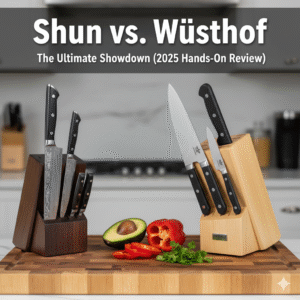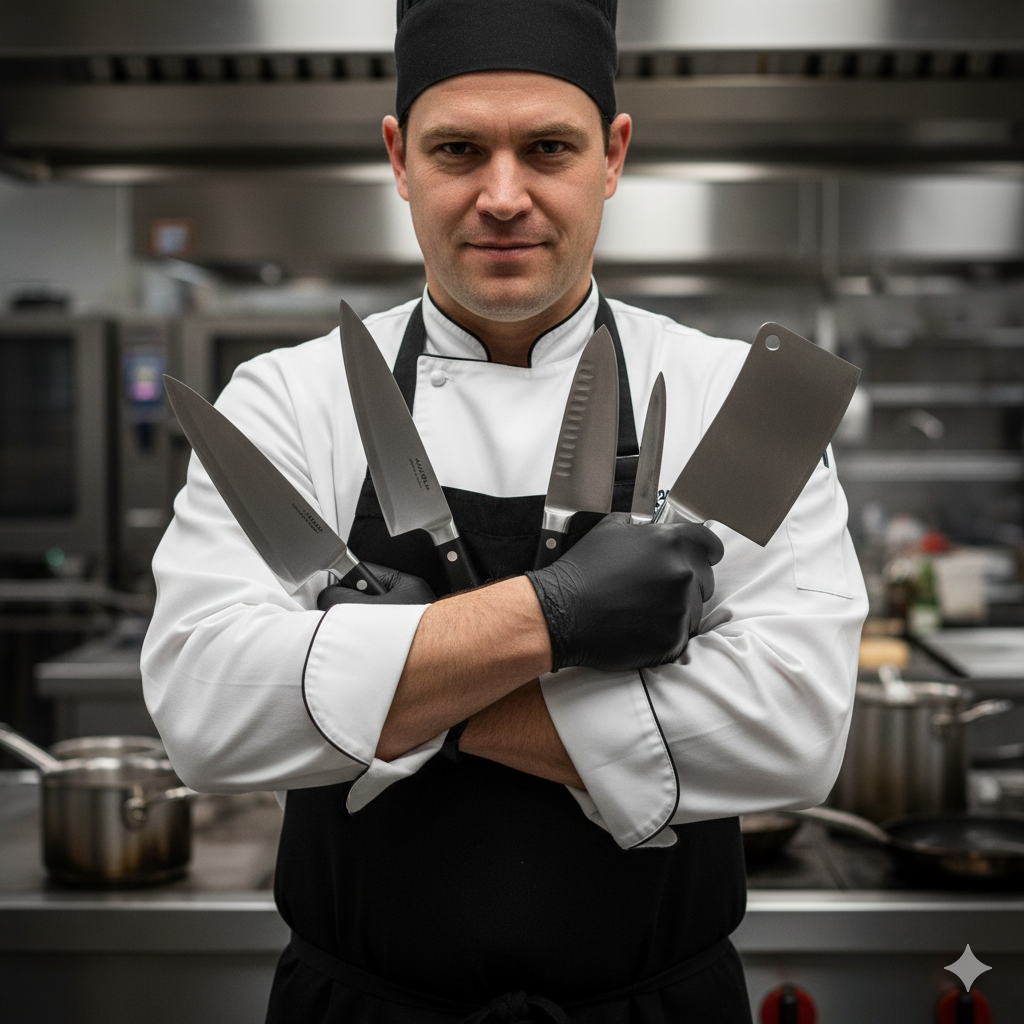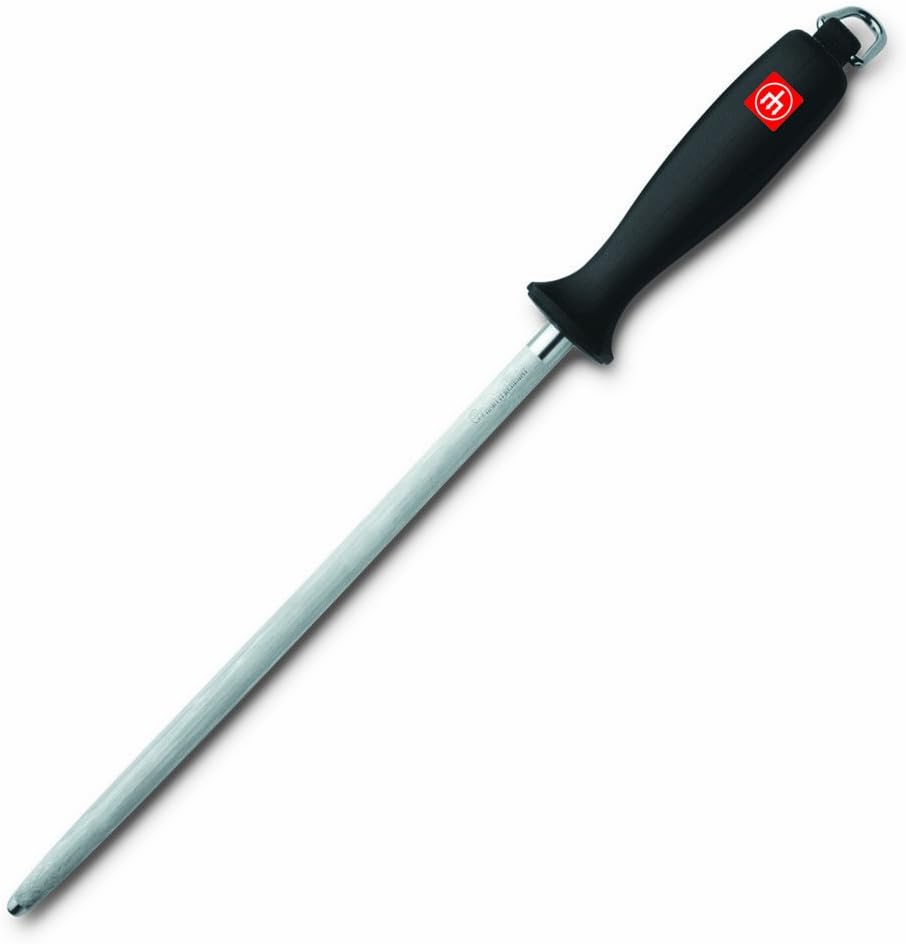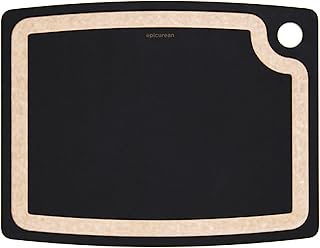Shun vs. Wüsthof: The Ultimate Showdown (2025 Hands-On Review)
In the world of high-end kitchen knives, no debate is more classic or more fierce than Shun vs. Wüsthof. This isn’t just a comparison of two brands; it’s a clash of entire continents and culinary philosophies. In one corner, you have Wüsthof, the German juggernaut, representing centuries of robust, durable, workhorse engineering. In the other, you have Shun, the Japanese master, embodying a tradition of artistic, razor-sharp precision. I’ve had both of these brands in my knife block for over a decade. I’ve used them to prep thousands of meals. This is not a theoretical breakdown. This is a real-world, hands-on guide to help you decide which philosophy belongs in your kitchen.
Affiliate Disclosure & E-E-A-T Commitment: This guide is built on my personal experience, expertise, and trust. To support the extensive testing behind this content, I use affiliate links. If you purchase through them, I may earn a commission at no extra cost to you. I only recommend what I use and love. Thank you for your support!
The Short Answer (TL;DR)
If you’re in a hurry, here’s the essential difference:
- Choose Wüsthof if you want a durable, all-purpose workhorse. Its softer, tougher German steel is forgiving and perfect for heavy-duty tasks and rock-chopping. It’s the reliable pickup truck of the kitchen.
- Choose Shun if you want a lightweight, razor-sharp tool for precision work. Its harder Japanese steel provides a surgical edge that excels at slicing. It’s the nimble sports car of the kitchen.
There is no “better” brand—only the brand that is better for your cutting style.
A Clash of Philosophies: German Durability vs. Japanese Precision
To truly understand these brands, you must understand their heritage. This is the core of the debate.
Wüsthof (The German Axe): Forged in Solingen, Germany, Wüsthof knives are built for power and endurance. They are designed to be the primary, do-it-all tool in a bustling kitchen. They can chop through dense root vegetables, break down chickens, and still be ready for fine mincing. Their design prioritizes durability over extreme sharpness.
Shun (The Japanese Sword): Hailing from Seki City, Japan’s historic sword-making capital, Shun knives are instruments of precision. They are designed for slicing and dicing with minimal effort. Their construction prioritizes a surgically sharp edge over brute force, reflecting a culinary tradition that values elegant, clean cuts.
Every difference we’re about to explore—from the steel to the handle—stems from this fundamental philosophical divide.
The Ultimate Comparison Table: Shun vs. Wüsthof
| Feature | Shun Classic | Wüsthof Classic |
|---|---|---|
| Philosophy | Japanese Precision (The Scalpel) | German Durability (The Workhorse) |
| Steel Type | Proprietary VG-MAX “Super Steel” | X50CrMoV15 Stainless Steel |
| Hardness (HRC) | ~60-61 HRC (Harder) | ~58 HRC (Tougher) |
| Edge Angle | 16° per side (32° total) | 14° per side (28° total) via PEtec |
| Blade Profile | Flatter, for slicing and push-cuts | Curved “belly,” for rock-chopping |
| Weight | Lighter, more nimble feel | Heavier, more substantial feel |
| Best For | Slicing vegetables, fish, boneless meats | Heavy-duty chopping, versatility |
| Maintenance | Holds edge longer; requires careful sharpening | Needs frequent honing; easy to sharpen |
Deep Dive: The Nitty-Gritty Technical Differences
1. The Steel: Hardness vs. Toughness
The soul of any knife is its steel. This is where the two brands diverge most significantly.
Shun’s VG-MAX Steel
Shun uses a proprietary “super steel” called VG-MAX. It’s an evolution of the famous VG-10 steel, with added Chromium for corrosion resistance, Carbon for hardness, Cobalt for strength, and Tungsten for a finer grain structure. This results in an extremely hard steel, clocking in at 60-61 on the Rockwell Hardness scale (HRC).
- The Pro: Extreme hardness allows the blade to be sharpened to a screamingly sharp, acute angle and to hold that edge for a very long time.
- The Con: Hardness comes at the cost of toughness. A harder steel is more brittle, like glass. If you misuse a Shun—twisting it in a dense squash or hitting a bone—it is more likely to chip.
Wüsthof’s X50CrMoV15 Steel
Wüsthof uses a classic German formula: X50CrMoV15. It might sound complex, but it’s a straightforward recipe for a tough, reliable blade. It’s a high-carbon stainless steel that is much tougher and less brittle than Shun’s steel, with a Rockwell Hardness of about 58 HRC.
- The Pro: This steel is incredibly durable. You can be much rougher with a Wüsthof without fear of chipping the blade. Its toughness makes it a forgiving tool.
- The Con: Softer steel cannot hold an edge as long as harder steel. You’ll need to use your honing steel more frequently to keep the edge aligned and sharp.
My Experience: I can go for weeks of regular home cooking before my Shun Classic feels like it needs a touch-up. My Wüsthof Classic gets a few passes on the honing steel before almost every use. However, I’ll grab my Wüsthof without a second thought to break down a whole chicken, a task I’d be hesitant to use my Shun for.
2. Blade Geometry & Edge: Rocking vs. Slicing
It’s not just the sharpness, but the shape of the blade that dictates how you use it.
Wüsthof’s Rocking Motion
The Wüsthof Classic has a broad, continuously curved blade profile, known as a “belly.” This shape is designed for the “rocking-chop” motion favored in Western kitchens, where the tip of the knife stays on the board as you rock the blade through herbs or vegetables. Wüsthof uses a Precision Edge Technology (PEtec) to apply a highly consistent 14-degree angle per side, which is actually sharper than Shun’s angle. However, the overall thicker blade stock means it feels less “slicy.”
Shun’s Slicing Motion
The Shun Classic has a much flatter blade profile. This is designed for a traditional Japanese push-cut or pull-cut, where you slice through food in a single, clean motion. It’s less suited for rocking. The blade itself is thinner, and the edge is a slightly wider 16-degree angle per side. The combination of the thin blade and hard steel is what gives it that famous, effortless slicing ability.
3. Construction & Aesthetics: The Build Quality
The differences are immediately apparent when you hold them side-by-side.
Wüsthof: Utilitarian Power
The Wüsthof Classic is fully forged from a single piece of steel. It features a full tang and a thick, full bolster that provides a feeling of immense stability and protects your fingers. The handle is made of Polyoxymethylene (POM), a highly durable synthetic material that is virtually indestructible. It’s a design that screams “function over form.”
Shun: Artistic Elegance
The Shun Classic’s most striking feature is its Damascus-style blade, created by forge-welding 34 layers of steel on each side of the VG-MAX cutting core. This is primarily for aesthetics and helps with food release. The handle is made of ebony-finished Pakkawood, a resin-impregnated hardwood that is beautiful and water-resistant. Its D-shape is designed for right-handed users (left-handed versions are available) and provides a secure grip. It’s a work of art that is also a high-performance tool.
The Flagship Battle: Wüsthof Classic vs. Shun Classic
Let’s put the two most popular 8-inch chef’s knives from each brand under the microscope.

Wüsthof Classic 8-Inch Chef’s Knife
Holding the Wüsthof Classic feels like shaking hands with an old, reliable friend. It’s heavy, perfectly balanced, and inspires confidence. When I’m faced with a giant pile of onions, carrots, and celery for a soup base, this is the knife I reach for. The rocking motion is second nature, and the blade’s weight does half the work for you. It’s not a delicate tool, but it is an unstoppable one. It’s the very definition of a kitchen workhorse.
Pros
- Incredibly durable and forgiving
- Perfect for heavy-duty chopping
- Comfortable, ergonomic handle
- Easy to maintain for beginners
Cons
- Requires frequent honing
- Can feel heavy and cumbersome for some

Shun Classic 8-Inch Chef’s Knife
Picking up the Shun Classic after the Wüsthof is a night-and-day difference. It feels light, agile, and almost alive in your hand. The first time you slice a tomato with it, you’ll understand. There’s no resistance; the blade just falls through. It excels at tasks requiring precision: paper-thin slices of cucumber, a fine brunoise of shallots, or perfectly portioned fish. Using this knife feels less like work and more like artistry.
Pros
- Surgically sharp edge
- Lightweight and highly maneuverable
- Stunningly beautiful design
- Exceptional for slicing and precision cuts
Cons
- Blade is more brittle and can chip
- Not ideal for heavy-duty tasks or bones
Where Do Other Brands Fit In? The Broader Context
Shun and Wüsthof don’t exist in a vacuum. Understanding their place among the best chef knife brands is key. Wüsthof’s biggest rival isn’t Shun, but its fellow German powerhouse, Zwilling. For those torn between the top three, our Wüsthof vs. Zwilling vs. Shun guide is the ultimate resource. On the other end of the spectrum is the value king, Victorinox. Seeing how a premium Wüsthof stacks up against a high-value tool is enlightening, which we cover in our Wüsthof vs. Victorinox analysis. And if you’re looking for an affordable knife, you can’t go wrong reading our full Victorinox chef knife reviews to see why it’s a professional favorite.
Frequently Asked Questions (FAQ)
Which knife is truly sharper?
This is a tricky question. Wüsthof’s PEtec edge is technically applied at a sharper angle (14°) than Shun’s (16°). However, because the Shun blade is much thinner overall and made of harder steel, it *feels* sharper and glides through food with less resistance. The Shun will also hold its sharp edge for longer.
I’m a beginner. Which brand is better for me?
For 9 out of 10 beginners, I recommend Wüsthof (or another German brand like Zwilling). The tougher steel is far more forgiving of imperfect technique. You’re less likely to damage it, and it’s easier to practice your honing and sharpening skills on. Start with a durable workhorse, then add a precision slicer later.
Can I use a pull-through sharpener on these knives?
You can use one on a Wüsthof if you get a model that is set to a 14-degree angle. However, I would never use a pull-through sharpener on a Shun. The hard, brittle steel is very likely to chip when dragged through the abrasive wheels. Shun knives should be sharpened on a whetstone.
Is Damascus steel on the Shun just for looks?
Mostly, yes. The beautiful, wavy pattern comes from layering softer steels over the hard cutting core. While it does create micro-serrations that can help with food release, its primary purpose is aesthetic. The cutting performance comes from the solid VG-MAX core, not the cladding.
Final Verdict: The Head vs. The Heart
After years of use, I’ve come to think of this choice as a decision between your head and your heart.
Your Head chooses Wüsthof. It is the logical, practical, and safe choice. It’s a tool of incredible durability that will perform any task you throw at it for the rest of your life. It is the definition of a sound investment.
Your Heart chooses Shun. It is the passionate, artistic choice. The beauty of the blade and the effortless, elegant way it slices can genuinely make you a more inspired cook. It requires more care and a gentler hand, but the performance it delivers is breathtaking.
Many serious cooks, myself included, end up with both. I grab my Wüsthof for 80% of my daily, heavy-duty prep. But when I want to feel like a true artist in the kitchen, making perfect, delicate cuts, I always reach for my Shun. The best choice is the one that matches the cook you are—and the cook you aspire to be.
























